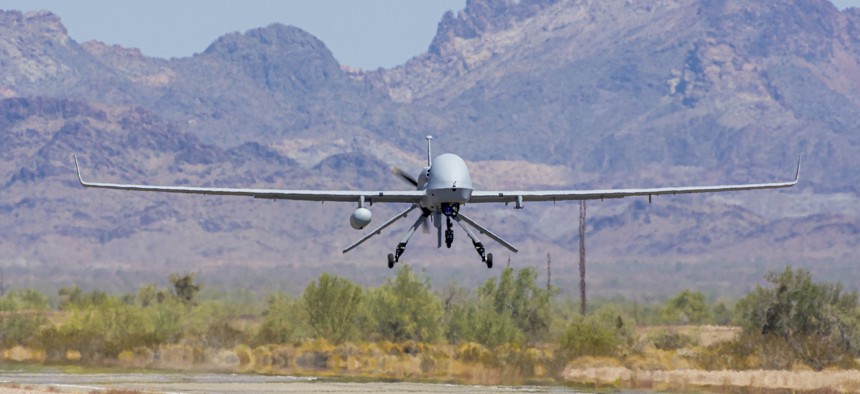
An Extended Range / Multipurpose (ER/MP) Unmanned Aircraft System (UAS), returns from functional testing during Project Convergence 20, at Yuma Proving Ground, Arizona, September 15, 2020. U.S. Army / Spc. Jovian Siders
The Biggest Lesson from the Army’s Connect-Everything Experiment
New labs to test interconnections are the key to joint all-domain command and control.
Three weeks of data-crunching at Aberdeen Proving Grounds convinced one top Army combat-development leader that he’s seen the way of the future.
In August, Army testers were preparing for next month’s Project Convergence experiment, the service’s flagship effort to try new ideas for linking data and accelerating operations. Last year’s version was less than perfect, Lt. Gen. James M. Richardson, deputy commanding general for combat development at Army Futures Command, acknowledged Tuesday. So testers decided to run data collected during the 2020 experiment through a “joint systems integration laboratory” at Aberdeen to get a better picture of how the various battlefield sensors and shooters were connecting.
The lab was, in essence, a place where the Army can look at various tools, software programs, and networks not to see if they work but to make sure that they connect with each other and with other nodes in the network. Compare that to traditional weapons testing, where the military simply tests to make sure the weapon or tool works by itself. It’s another example of the military gradually overcoming communication barriers between services and pieces of equipment.
The August analysis “paid huge dividends” and helped set this year’s Convergence effort up to be grander in scope, Richardson said at the AUSA conference in Washington, D.C.
More importantly, he said, such integration labs need to be a bigger part of the way the military buys and builds everything.
“All of science and technology should be in those labs,” including all programs of record, Richardson said. “Let’s run everything in the lab to learn before we go and buy or go into the field. I tell you, we just had two weeks of prep for the exercise. I don’t know what we would have done if we had not taken all these 110 technologies [and] seven use cases, and ran them in the laboratory.”
As the military continues to move toward a vision of highly networked warfare with lots of streaming data enabling artificially-intelligent aids to make faster target recommendations, they are continuing to find that simply connecting weapons and vehicles within a single service is harder than many had anticipated. It’s even harder with partner militaries.
Gen. John Murray, the head of U.S. Army Futures Command, acknowledged Tuesday that the digital multi-party environment for exchanging targeting and other data between the United States and international partners is “nowhere near where it needs to be.”




